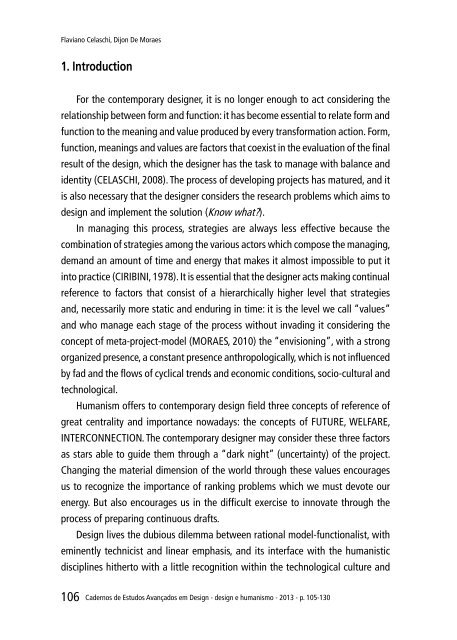o_19po8js951tvs1r0t1r8s4bb1vpla.pdf
Create successful ePaper yourself
Turn your PDF publications into a flip-book with our unique Google optimized e-Paper software.
Flaviano Celaschi, Dijon De Moraes<br />
1. Introduction<br />
For the contemporary designer, it is no longer enough to act considering the<br />
relationship between form and function: it has become essential to relate form and<br />
function to the meaning and value produced by every transformation action. Form,<br />
function, meanings and values are factors that coexist in the evaluation of the final<br />
result of the design, which the designer has the task to manage with balance and<br />
identity (CELASCHI, 2008). The process of developing projects has matured, and it<br />
is also necessary that the designer considers the research problems which aims to<br />
design and implement the solution (Know what?).<br />
In managing this process, strategies are always less effective because the<br />
combination of strategies among the various actors which compose the managing,<br />
demand an amount of time and energy that makes it almost impossible to put it<br />
into practice (CIRIBINI, 1978). It is essential that the designer acts making continual<br />
reference to factors that consist of a hierarchically higher level that strategies<br />
and, necessarily more static and enduring in time: it is the level we call “values”<br />
and who manage each stage of the process without invading it considering the<br />
concept of meta-project-model (MORAES, 2010) the “envisioning”, with a strong<br />
organized presence, a constant presence anthropologically, which is not influenced<br />
by fad and the flows of cyclical trends and economic conditions, socio-cultural and<br />
technological.<br />
Humanism offers to contemporary design field three concepts of reference of<br />
great centrality and importance nowadays: the concepts of FUTURE, WELFARE,<br />
INTERCONNECTION. The contemporary designer may consider these three factors<br />
as stars able to guide them through a “dark night” (uncertainty) of the project.<br />
Changing the material dimension of the world through these values encourages<br />
us to recognize the importance of ranking problems which we must devote our<br />
energy. But also encourages us in the difficult exercise to innovate through the<br />
process of preparing continuous drafts.<br />
Design lives the dubious dilemma between rational model-functionalist, with<br />
eminently technicist and linear emphasis, and its interface with the humanistic<br />
disciplines hitherto with a little recognition within the technological culture and<br />
106<br />
Cadernos de Estudos Avançados em Design - design e humanismo - 2013 - p. 105-130



